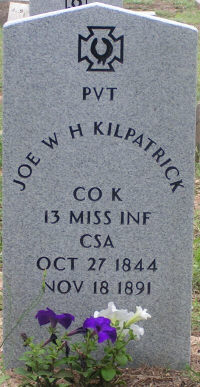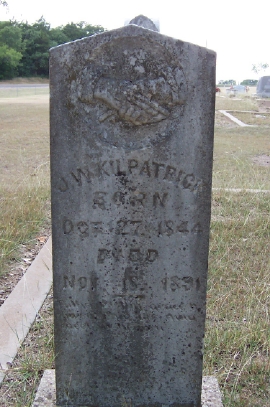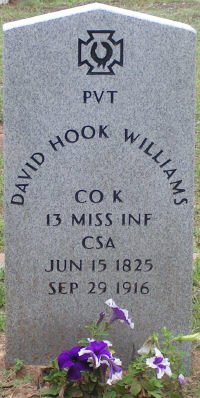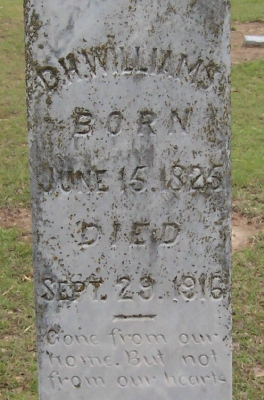|
Joe William H. Kilpartick


Marker Photos by
Dana Stubbs &
Karen Rost
David Hook William


Marker Photos by
Dana Stubbs &
Karen Rost
Grange Hall Cemetery Life was very hard for
families while their men were at war but as all Southerners they made do with
what they had. As one family records in the Navarro County History Book; the war
was in full swing at the time David Hook Williams left his family to fight for
the Confederacy.
His wife Catherine was left alone with five children to take care of.
This she did along with the farm and house. We can imagine it must have been
very hard for her during those bleak days of the war but like all southern
women, she did what she had to do. David had been captured at the battle
Knoxville and was a prisoner at Rock Island, Illinois until he took his oath of
allegiance and came home in June 1865. In the year of 1870 David Hook Williams
helped to organize a wagon train that included many families of Meridian. This
train would take them to land of opportunity, Texas. They left in November of
1870 and arrived in Corsicana after 6 weeks of hardship on the road. After
arriving in Texas, the families settled down to the usual farm life routine of
Cryer Creek, Kelm and Grange Hall.
Catherine Williams was the mother-in-law of Joe W. H. Kilpatrick who also served
in the same Co K, 13th MS Inf Regiment along with David Hook Williams. This unit
which completed its organization at Corinth, MS, in May 1861 had its members
raised in several counties including Lauderdale. Ordered to Virginia it saw
action at First Manassas and Leesburg. The unit was brigaded under Generals
Griffith, Barksdale, and Humphreys, Army of Northern Virginia. It fought with
the army from the Seven Days' Battles to Cold Harbor except when it was with
Longstreet at Chickamauga and Knoxville. After participating in Early's
operations in the Shenandoah Valley, the 13th shared in various conflicts around
Appomattox and surrendered on April 9, 1865.
Notes:
LEFT FOR DEAD.
D. H. Williams, Ninety-one Years Old, Wounded at Gettysburg.
Mr. D. H. Williams of Barry was in town today. He is ninety-one years old, but
doesn’t look it by a quarter of a century. He is active in body and his mind is
perfectly clear.
Mr. Williams is a Confederate veteran and saw much service in the war. He was
wounded three times but only one of these wounds, he says, was serious. He was
in twenty-feet of the man who shot him down at Gettysburg. This occurred about
noon on July 3rd, 1863. About the same hour that night he regained consciousness
and left the battlefield. The other wounded had been carried away, he being left
for dead. Mr. Williams said that his brother was told by a comrade who was
standing by him when he received the wound, that he “never saw a man killed
deader,” meaning that to the comrade death seemed to have come the instant the
bullet struck him. Mr. Williams’ brother spent the night looking for him and
just at daylight ran face to face with a squad of Federal soldiers. He fled and
although not less than forty shots were fired at him he escaped injury.
Notes:
|



